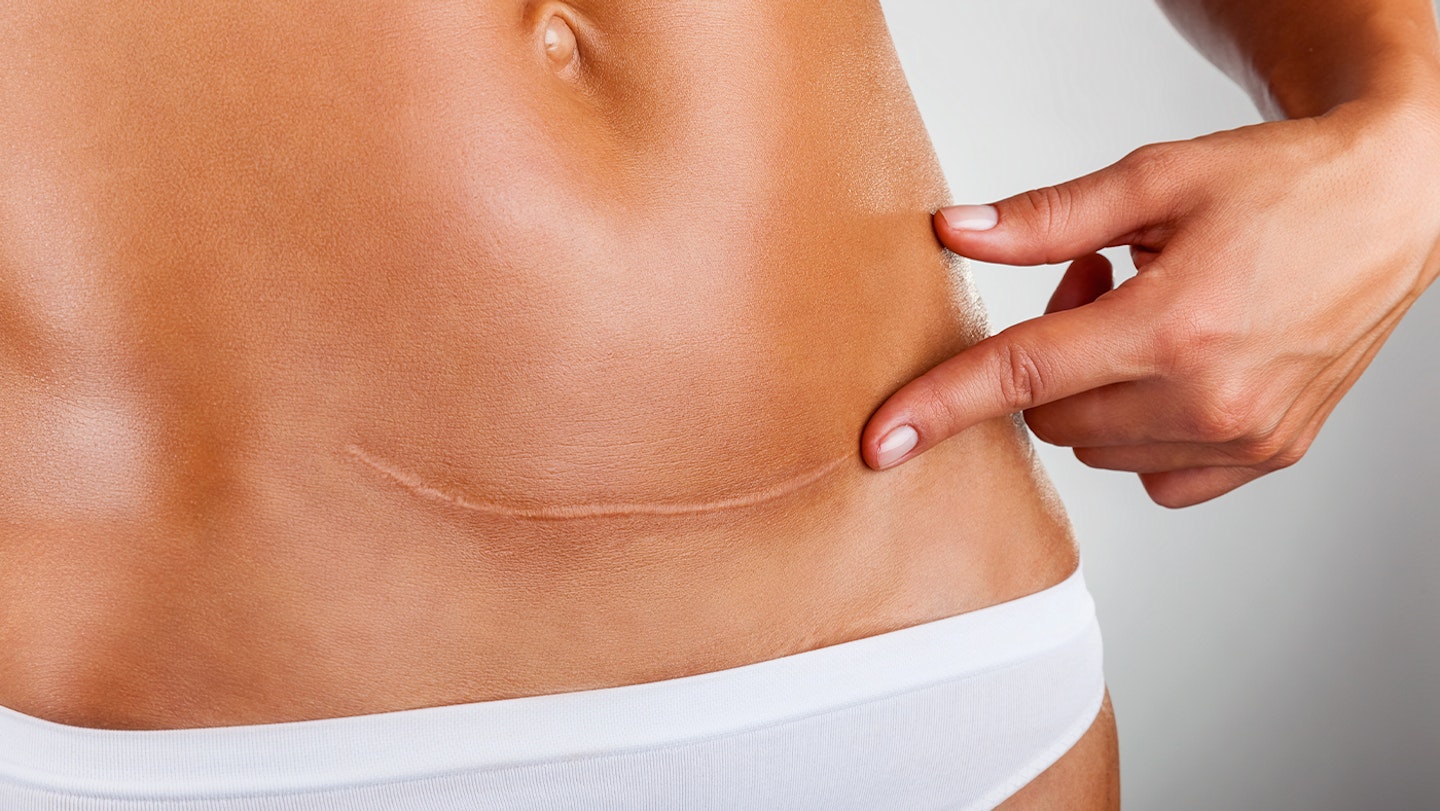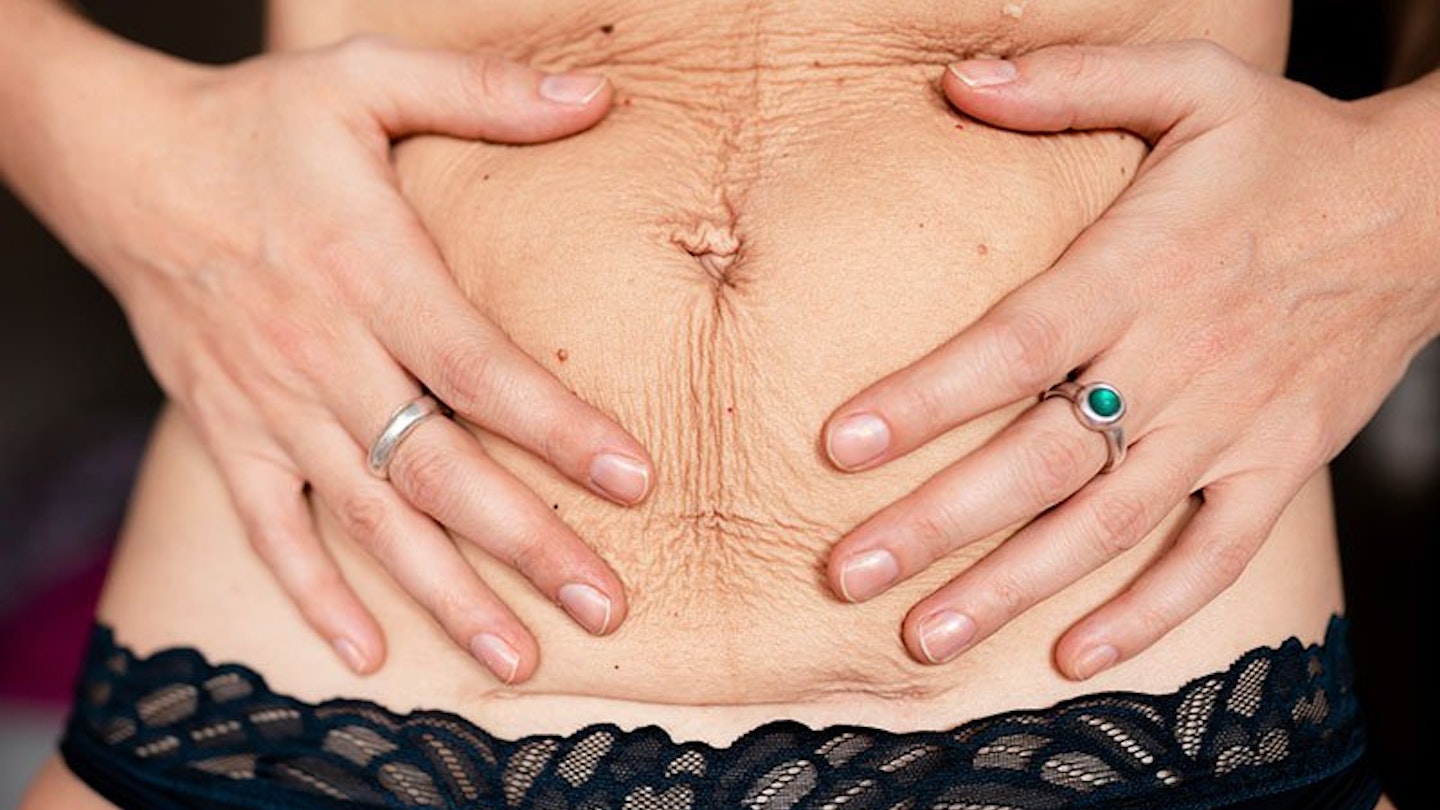While some women choose to have a c-section, for other women, it's the safest way for their baby to enter the world, and with it comes a lasting c-section scar. More than just a surgical mark, the c-section scar often becomes a powerful reminder of the day your little one arrived, even celebrities like Angelina Jolie, Kate Winslet, and Paloma Faith, have proudly acknowledged the surgery and embraced the mark that made them proud parents.
Whether your c-section is planned, or you end up having emergency surgery, understanding what to expect during c-section recovery. and how to look after your skin is crucial. To help you achieve this, we spoke to Douglas McGeorge, Founder of Science of Skin, one of the leading surgeons in the UK to answer all your cesarean scar-related questions.
Types of c-section scars and incisions
Whether you've had a natural c-section or opted for an elective c-section, your incision will be horizontal just on your bikini line. This kind of incision is used in around 95 per cent of c-sections because it often means less bleeding due to the positioning, and it's also less likely to split if you have a VBAC (Vaginal Birth After Cesarean).
In very rare cases, such as some emergencies or if baby is quite premature, a vertical incision might be made. This happens down the middle of the uterus. These incisions tend to be more painful and take longer to heal.
In most cases, your c-section scar will heal well and will fade naturally over time. Sometimes however, in some cases keloid scarring and hypertrophic scarring can occur. This means that the scar is raised more. If you think something isn't right with the healing process, it's a good idea to speak to your GP.
How is the incision closed?
A c-section consists of two incisions, the surgeon will make an abdominal incision, and then a uterine incision to remove the baby. The inner incision on the uterus is always closed with dissolvable stitches. However, the outer incision on your skin can be closed with a number of methods.
Stitches - Using a needle and thread, your doctor will close the incision. Although it can take a little more time than other methods, many experts think this is the best option.
Staples - Using a skin stapler is the quickest and easiest option.
Glue - Surgical glue can be used in some cases depending on how successful the c-section went and the consistency of your skin.
Aftercare: how to help your c-section scar heal
Firstly, know that you’ll be in hospital at least 48 hours after you have a caesarean section. After this you will need to take things easy, which means no driving for 6 weeks after. By two weeks, your scar should be healing well and it look better. You should also feel much better in yourself. However, a gentle reminder, that recovery can vary and everyone has a different experience - it can take anywhere from six weeks to three months before you've properly healed and feel fully stronger.
Before you leave hospital, your midwife will advise you on how best to take care of your wound when you're at home. To help your scar heal, follow these rules:
Keep the wound clean - Once you have your bandage removed you can shower (before this shower around the bandage, which is tricky). It’s advised to clean and dry the wound every day. In addition to this, don’t use perfume or body spray on or around the wound.
Get comfy - Wear comfortable clothing, as loose as feels comfortable for you. "I would advise my patients to wear clothes that are loose-fitting directly after surgery so as not to disturb the wound. After your scar starts to heal, if it is symptomatic (red, sore and itchy) make sure you manage it with a cream and choose materials that are breathable and not irritating the scar directly," says Douglas.
Air it out - When you can, try to expose your scar to air to get air circulating around your wound. This promotes healing.
Ease the pain - Take painkillers if the wound is sore, paracetamol should do the trick. According to Douglas, most scars should stop hurting around the six-month mark. "Sometimes if there has been nerve damage it can take longer for the body to heal. Massages help to stop the pain from nerve damage, and if your scar is still very sore and red. Solution for Scars has been designed and developed to treat symptomatic scars that are sore and uncomfortable - so that might help as well."
If you're struggling with pain while you're trying to breastfeed, read our guide on breastfeeding after a c-section and the best positions to try.
Attend your appointments - Any dissolvable stitches will obviously go by themselves, but if they're not dissolvable stitches or if you have staples, be sure to go along to your follow up appointment where they will be carefully removed by your midwife. This is also a great opportunity to discuss any concerns you have about the healing process.
Stay active - Although you won't be off on an intense run any time soon, (and having sex after a c-section is probably still the last thing on your mind) it's still important to exercise after a c-section. Walking is great once you feel up to it as it's a gentle form of exercise and increases blood flow to help you avoid Deep Vein Thrombosis (DVT).
Minimising your c-section scar
Eventually the wound will form a scar. The scar you’ll most likely see is after a horizontal incision, about 10-20cm long, just below your bikini line. In some rare case, a scar will look vertical and appear just below your belly button.
According to Douglas, "Scar management is really important to get the very best possible result from your scar. When your wound has fully closed and stitches have been removed, start to gently massage in a scar treatment that has been specifically designed to be used from the moment your scar is still red, pink, irritable and sore. Solution for Scars contains very effective but gentle green tea extracts that work to reduce redness and irritation and therefore stop you itching or disturbing your wound as it heals - giving you the very best chance of achieving a less noticeable scar from your c-section."

Although it might appear red at first, it should fade to be quite flat and pale in time, and your pubic hair may even cover it.
"Unfortunately, despite what some may claim, you can never get rid of a scar completely. The very best result for any scar is a flat silver / white thin line that is barely noticeable - but you will still have a scar," says Douglas.
It's normal for your scar to itch (but avoid scratching it) and for it to feel numb. These sensations will go away in time, but if it's beginning to bother you, speak to your GP.
Non-surgical procedures to minimise a c-section scar
Laser therapy – This can help discolouration but you may need a number of treatments to achieve what you're perfect result.
Steroid injections – In extreme cases where the scar is more aggressive, steroid injections can help to flatten it. Speak to your doctor about this option at the time of the c-section if your skin is liable to keloid scarring.
Scar massages – If you see your c-section scar has opened up a bit during healing and is now a bit of a lump, massages may help smooth it out. "Try massaging it every day in the morning and at night for about 3 minutes - it may seem like a long time - but you should be able to feel results. If it's still bothering you or is particularly annoying, a revision can be considered to give you a better result through plastic surgery," says Douglas.
Surgical procedures
Tummy tuck – To combat loose skin on your stomach post c-section, some mums have a tummy tuck.
Scar revision – This can help the scar appear thinner and less visible.
Signs of infection to watch out for after a c-section
While the scar is healing, it's normal to experience things like pain, bleeding, numbness and sometimes itching, but it’s important to contact your GP straight away if any of the below symptoms crop up as it could be a sign of infection:
• You have a fever
• You get a cough or shortness of breath
• Scar leaking a discharge of is foul-smelling
• Watch out for signs of infection; increased redness, swelling or pain
• Pain while peeing
• Swelling or pain in your lower leg
• Heavy vaginal bleeding
FAQs c-section
Will my c-section pooch ever go away?
The 'pooch' of skin will shrink down, it may not completely settle for everyone but allow lots of time for the tissues to get back to normal and heal. Some opt for surgery as exercise and age may not move it alone. For others an exercise and focusing on core exercises and a good diet can be enough to flatten the appearance of this pouch.
Why does the c-section area feel numb?
This is something that unfortunately can occur with a c-section. The 'numb' sensation will continue to improve over the first year and the quality can improve for another year. Sometimes, however, it may never recover fully, but usually, protective sensation will return. Massages can help any discomfort and pain as the tissues settle back down.
What happens if you don't massage a scar?
It's crucial to continue massaging your scars for at least three to six months post-surgery or injury. Neglecting this can lead to the scar becoming hard and inflexible, potentially forming adhesions.
About the expert
Douglas McGeorge OBE, Founder of Science of Skin, is one of the UK’s leading cosmetic surgeons who has developed a breakthrough cult scar treatment cream, Solution for Scars which includes a maternity stretch mark range.
About the author
Lorna White is a Senior Digital Writer and has written for Mother&Baby since 2020. She has a keen interest in a range of topics, from potty training and nutrition to baby names and maternity fashion.
